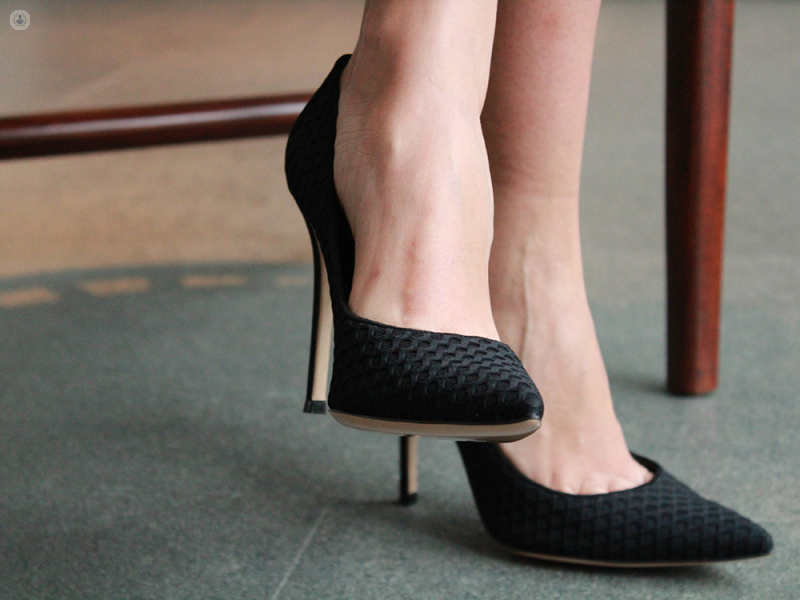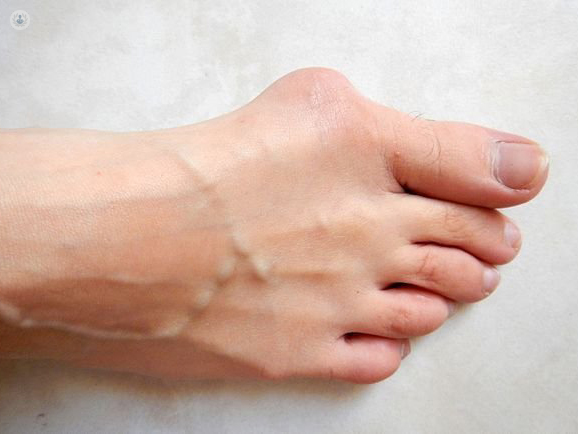Bunion overview - causes, risk factors and your treatment options
Written by:Bunions are a painful swelling at the base of the big toe. Whilst they can be genetic and run in families, they are often exacerbated by wearing shoes that are too small, or excessively high heels that force the toes into the end of the shoe.
Around 80% of cases are seen in women, and in countries where most people wear flip-flops or go barefoot, bunions are rare.
In this article, consultant orthopaedic surgeon, Mr Henry Willmott explains the main causes of bunions, how you can reduce your risk of one developing and what treatment options are available.

What causes bunions?
Contrary to common belief, most bunions are not caused by the growth of extra bone but are usually due to the development of an abnormal bend or curve of the first metatarsal bone - the bone just behind the big toe. This results in excessive width at the front of the foot, causing problems fitting your feet into shoes. If left untreated the big toe can become so angulated that it overcrowds or even crosses-over the other toes.
Bunions can be genetic and run in families, however, they are usually exacerbated by wearing shoes that are too small, or excessively high heels that force the toes into the end of the shoe.
What are the symptoms of a bunion?
Generally, the pain caused by bunions is confined to the big toe but in some cases, pain can also be felt under the second or third toes.

The skin may become red and inflamed and with time, hard callosities develop. People may also develop a limp and subsequent problems with hips, knees and the spine.
What can you do to reduce the risk of bunions developing?
There are some simple precautions you can take in regards to footwear to help prevent the formation of a bunion.
- Firstly choose appropriate shoes that are wide fitting and are also deep enough to accommodate the toes comfortably.
- Feet can increase by as much as 1.5 shoe sizes from morning to afternoon, so when shopping for shoes it is better to go in the afternoon when your feet will be at their largest. Many women unwittingly wear shoes that are too small for them.
- Aim to wear flat shoes as much as possible.
- Go barefoot or wear flip-flops when possible at home.
How can you relieve bunion pain?
If bunions do develop, there are various ways to help reduce the pain such as wearing extra-wide shoes or padding areas of discomfort. Ice packs may also be helpful to reduce inflammation.
You should see an orthopaedic foot and ankle specialist if:
- You have persistent pain
- You are having trouble finding shoes which fit
- You have pain in the second or third toes
- You have decreased movement in the big toe
- Your toes are crossing over
What treatment options are there?
As a consultant orthopaedic surgeon specialising in foot and ankle problems, bunion surgery is one of the commonest procedures I perform. Treatment depends on each individual case but generally involves an operation to realign the bone, which is held in place with screws. The ligaments around the joint are also realigned. Sometimes the second and third toes may also need to be corrected. This straightens the toes and rebalances the foot to minimise the risk of recurrence.
How is bunion surgery performed?
I carry out this procedure under general anaesthetic and also numb the foot with injections of a local anaesthetic to ensure that patients wake up pain-free. Most people can go home the same day.
Patients will be able to walk immediately, although they may feel uncomfortable for the first few weeks as they heal. It is very important to rest after the operation and to raise the foot as much as possible to minimise swelling.
Patients will return to work after 4-6 weeks if they are able to rest their feet. For those whose jobs are more active, it is advisable to take 8-10 weeks off.
Following the operation, the toe will look straight once again. Patients will be able to return to normal activities including sports and wear normal shoes, even small heels.
Further detailed patient information about bunions and other foot and ankle problems is available on Mr Henry Willmott's website.
Alternatively, you can make an appointment to see him at KIMS Hospital in Maidstone or Spire Sussex Hospital in Hastings by going to his Top Doctors profile.


